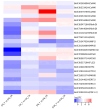Transcriptome Analysis of Ethylene-Related Genes in Chlorine Dioxide-Treated Fresh-Cut Cauliflower
- PMID: 39202461
- PMCID: PMC11353629
- DOI: 10.3390/genes15081102
Transcriptome Analysis of Ethylene-Related Genes in Chlorine Dioxide-Treated Fresh-Cut Cauliflower
Abstract
Chlorine dioxide (ClO2) is widely used for the quality preservation of postharvest horticultural plants. However, the molecular mechanism of how ClO2 works is not clear. The purpose of this study was to understand ethylene-related molecular signaling in ClO2-treated fresh-cut cauliflower florets. Transcriptome analysis was used to investigate ethylene-related gene regulation. A total of 182.83 Gb clean data were acquired, and the reads of each sample to the unique mapped position of the reference genome could reach more than 85.51%. A sum of 2875, 3500, 4582 and 1906 differential expressed genes (DEGs) were identified at 0 d, 4 d, 8 d and 16 d between the control group and ClO2-treated group, respectively. DEGs were enriched in functions such as 'response to oxygen-containing compounds' and 'phosphorylation', as well as MAPK signaling pathway, plant hormone transduction pathway and so on. Genes, including OXI1, MPK3, WRKY22 and ERF1, which are located at the junction of wounding, pathogen attack, pathogen infection or ethylene signal transduction pathways, were up-regulated in response to stress. ETR and CTR1 (both up-regulated), as well as three down-regulated genes, including BolC5t34953H (a probable NAC), BolC1t05767H (a probable NAC) and BolC2t06548H (a probable ERF13), might work as negative regulators for ethylene signal transduction. In conclusion, ethylene-related genes and pathways are involved in ClO2 treatment, which might enhance stress resistance and have a negative feedback mechanism.
Keywords: RNA-seq; chlorine dioxide; ethylene; fresh-cut cauliflower; stress; transcriptome.
Conflict of interest statement
The authors declare no conflicts of interest. All authors have read and agreed to the published version of the manuscript.
Figures







Similar articles
-
Ultra-low concentration of chlorine dioxide regulates stress-caused premature leaf senescence in tobacco by modulating auxin, ethylene, and chlorophyll biosynthesis.Plant Physiol Biochem. 2022 Sep 1;186:31-39. doi: 10.1016/j.plaphy.2022.06.029. Epub 2022 Jul 2. Plant Physiol Biochem. 2022. PMID: 35803089
-
Transcript Profiling and Gene Identification Involved in the Ethylene Signal Transduction Pathways of Creeping Bentgrass (Agrostis stolonifera) during ISR Response Induced by Butanediol.Molecules. 2018 Mar 20;23(3):706. doi: 10.3390/molecules23030706. Molecules. 2018. PMID: 29558428 Free PMC article.
-
Transcriptomic analysis of cut tree peony with glucose supply using the RNA-Seq technique.Plant Cell Rep. 2014 Jan;33(1):111-29. doi: 10.1007/s00299-013-1516-0. Epub 2013 Oct 17. Plant Cell Rep. 2014. PMID: 24132406
-
Aqueous chlorine dioxide treatment of horticultural produce: Effects on microbial safety and produce quality-A review.Crit Rev Food Sci Nutr. 2018 Jan 22;58(2):318-333. doi: 10.1080/10408398.2016.1169157. Epub 2017 Jun 28. Crit Rev Food Sci Nutr. 2018. PMID: 27196114 Review.
-
The ethylene gas signal transduction pathway: a molecular perspective.Annu Rev Genet. 1998;32:227-54. doi: 10.1146/annurev.genet.32.1.227. Annu Rev Genet. 1998. PMID: 9928480 Review.
References
-
- Avato P., Argentieri M.P. Brassicaceae: A Rich Source of Health Improving Phytochemicals. Phytochem. Rev. 2015;14:1019–1033. doi: 10.1007/s11101-015-9414-4. - DOI
-
- Morrison M.E.W., Hobika E.G., Joseph J.M., Stenzel A.E., Mongiovi J.M., Tang L., McCann S.E., Marshall J., Fountzilas C., Moysich K.B. Cruciferous Vegetable Consumption and Pancreatic Cancer: A Case-Control Study. Cancer Epidemiol. 2021;72:101924. doi: 10.1016/j.canep.2021.101924. - DOI - PMC - PubMed
MeSH terms
Substances
Grants and funding
LinkOut - more resources
Full Text Sources
Research Materials

